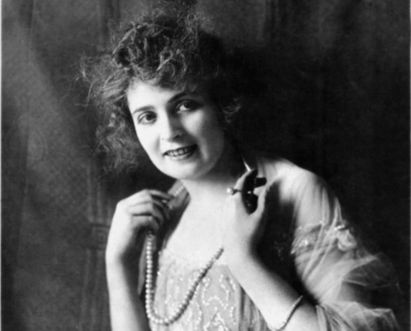Quick Look at Myrtle Gonzalez
Myrtle Gonzalez, the “First Latin American Movie Star,” set the norm in Hollywood. LA-born Myrtle was born on September 28, 1891. Her Mexican parents brought her. Her rise to fame was remarkable.
Myrtle has loved performing since childhood. She was a talented singer and dancer at local gatherings. Director Thomas Ince spotted her in a community production, giving her a great break.
At 19, Myrtle debuted in “The Invaders” (1912), a silent western. This made her famous in Hollywood. She performed in nearly 80 films in the following decade, including “One Law for Both” (1917), “The Serpent” (1916), and “The Easter Lily” (1915).
Beauty and charisma made Myrtle one of the most famous actors of her time. Her sharp wit and positive outlook earned her the nickname “La Única,” meaning “the unique one.”
Great actress Myrtle pioneered women in movies. Myrtle played complex characters that challenged gender norms when women were usually femme fatales or damsels in distress.
Early years and work
On September 28, 1891, she was born in Los Angeles. Mexican exiles Francisco Gonzalez and Maria Rodriguez lived in the US. Their fifth child and youngest mother ran the household while her father built it.
Myrtle was exposed to many cultures and languages growing up in busy Los Angeles. In a mixed-race community, she learned English from friends and Spanish from her parents.
When Myrtle was 14, a touring vaudeville act performed at her school greatly affected her life. Attracted to the theater, she convinced her parents to let her work as a company assistant. Playing was her passion, and she became a professional.
Beginning a Career
Small Los Angeles shows improved Myrtle’s acting. She did ballet, flamenco, and more.
In 1911, 20-year-old Myrtle debuted in D.W. Griffith’s “The Immigrant.” Although she was tiny, her role sparked her rich Hollywood career.
Over the next four years, Myrtle appeared in silent films such “The Little American” (1917) with Mary Pickford and “E
Be renowned in silent films.
In silent films in the early 1900s, Mexican-American actress Myrtle Gonzalez was called “The Virgin of the Silver Screen” for her beauty. Myrtle worked hard and was skilled, so she rose from lowly jobs when Hispanic artists had few opportunities to become sought-after actors.
On September 28, 1891, she was born in Los Angeles. Spanish mother and American father nurtured her. She lived among a variety of people. She loved playing there and appeared in local performances. Mack Sennett hired her as a Keystone Studios film director because of her elegance and tranquility.
The 1913 short film “Giving Them Fits” introduced Myrtle. It started a 20-year career despite its small size. She became famous quickly for her expressive eyes and nonverbal communication. This helped her gain larger roles in The Silent Witness (1917) and Love’s Forgiveness (1915).
After appearing in Roscoe “Fatty” Arbuckle’s comedy “Fatty’s Plucky Pup” (1915), Myrtle became popular. Onscreen, they got along and went.
My personal life and relationships
Relations influenced Myrtle Gonzalez as a person and actress. The Los Angeles native was born on September 28, 1891. Their parents were Indian. Since her mother was a vocalist and her father a theater performer, Myrtle loved performing early on.
Myrtle grew up with her family and attended performances. At sixteen, she debuted on stage to tremendous reviews. Once she created movies, she became famous.
Lady Myrtle married twice. Her first marriage was to silent film director George Marshall in 1913. Their personalities were too different, so they divorced after six years. Photographer Allen McNeil married Myrtle again in 1929 and stayed with her until 1950.
Myrtle worked hard despite her love-life issues. Actresses Ramona Novarro and Dolores Del Rio were her friends.
The media covered her private dress sense. Myrtle’s beauty on and off the screen in silent films cemented her stylish legacy.
Legacy of Myrtle Gonzalez
Myrtle Gonzalez inspires actors and actresses. Hollywood’s Mexican-American actress blazed the way for Latinx actors.
Myrtle Gonzalez was born on September 28, 1891, in Los Angeles. Stardom was her birthright. Her father managed popular theaters, and her mother acted in plays. No wonder Myrtle adored playing as a kid. She started working at age three and performed throughout her childhood.
Myrtle pursued acting full-time after high school. She had numerous small, silent film roles before Thomas Ince discovered her. Myrtle was so good that Ince led her in “A War-Time Widow” (1915). Her Hollywood stardom began here.
Myrtle became a fan favorite because she was pretty, nice, and good at playing. After playing Milly Erne in “The Virginian,” she was called “The Virginian Beauty” (1914). She worked with 1910s Hollywood stars Douglas Fairbanks Sr., William S. Hart, and others.
Fights, Scandals
Like many celebrities, Myrtle Gonzalez had a scandal. Despite Hollywood’s success, her personal life was controversial.
Herbert Blaché and Myrtle Gonzalez’s affair was renowned. Blaché married Alice Guy-Blaché, a pioneering female actor. His 1922 divorce request followed his affair with Myrtle. It harmed Blaché and Myrtle’s Hollywood reputations.
Throughout her career, she experienced yet another Mexican incident. She faced racism owing to her appearance and her name, despite being Spanish and born in Los Angeles. During Mexican-American discrimination in Hollywood, Myrtle strove to escape roles like “the exotic temptress” and “the fiery Latina.”
Myrtle’s romances circulated. She flirted on set with many co-stars in couples. When one of these partnerships occurred, Francis X. Bushman was Hollywood’s biggest star. Despite speculation, Bushman’s marriage prevented their relationship from being confirmed.
Other controversies surrounded these confrontations.
Hollywood and pop culture change.
Myrtle Gonzalez’s “The American Beauty” starred in early 1900s silent films. Her brief acting career shaped Hollywood and modern culture.
Her 1914 cinema debut in “The Count of Monte Cristo” made her famous. Her natural beauty and captivating film presence charmed fans and reviewers. One of the most sought-after actors of her day. Each role boosted her fame.
Gonzalez created the female movie role cliché, changing Hollywood. She often encountered femme fatales or damsels in distress. Gonzalez challenged social norms by giving her characters depth and nuance, allowing more female leads.
She made Latinx-starring films conceivable. This pioneering Mexican-American actress opened the way for others. She defied preconceptions and proved that non-whites can succeed in white fields.
Gonzalez affected pop culture outside Hollywood. Americans loved her beauty and her distinctive style-inspired fashion. Gonzalez influenced young ladies to copy her hair and outfits.
Awards honoring Myrtle Gonzalez
Myrtle Gonzalez was the first Latina film star. Her legacy as a great actress endures. She inspired many Latino actors, and her brief but successful Hollywood career left an influence.
This section describes Myrtle Gonzalez’s honors. Tributes and accolades commemorate her film’s achievements.
Honors after death
At 27, Myrtle Gonzalez died suddenly, but her skills were remembered. Her film efforts earned her an Oscar after her death. She won a bronze plaque from Photoplay Magazine in 1919 for playing “The Mexican.”
Alma de Mexico magazine named her “the most beautiful woman in Mexico.” 1920. These awards recognize Myrtle’s impact on US and Latin American fans.
Star of Hollywood Walk of Fame
Myrtle Gonzalez got a Hollywood Walk of Fame star in 1960. This honor is among the highest for actors and is only given to individuals who have greatly affected entertainment.
Conclusion
Early Hollywood actress Myrtle Gonzalez revolutionized film. Despite obstacles, she persevered and encouraged future actors and actresses. She transformed film history, making her renowned. Pioneering Mexican-American Hollywood star Myrtle Gonzalez Her talent, dedication, and love of performing will be remembered.

